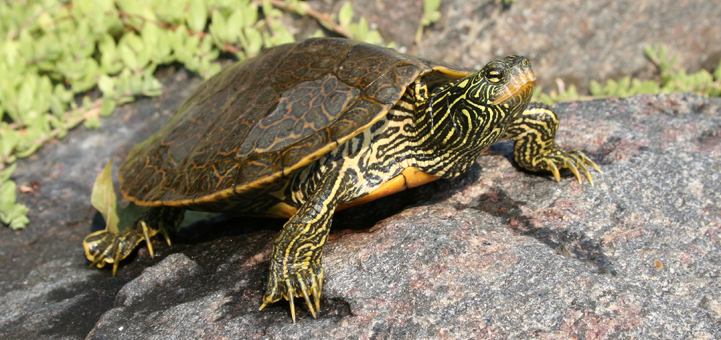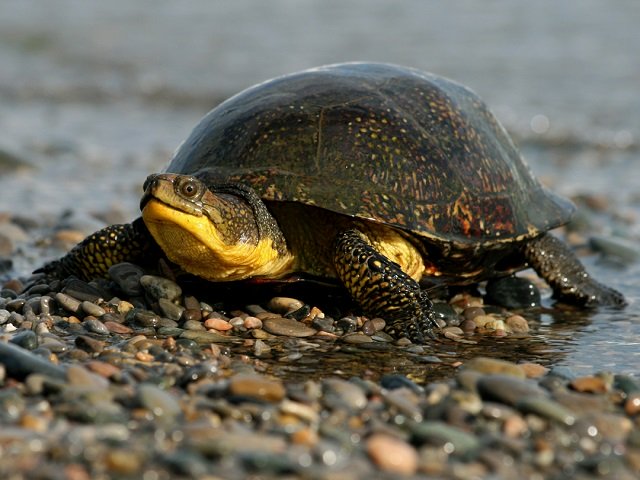
All of Ontario’s turtles are now at risk
By Jenn McCallum, GreenUP Water Programs Coordinator
While spending time by the lake or river this summer, you may see turtles basking in the sun along rocks or logs. Hopefully, you are fortunate enough to see one; as of this spring, all eight of Ontario’s turtle species are considered at risk due to natural and human-caused factors.
Prior to April 2018, the Midland Painted Turtle was not considered at risk. But recently the Committee on the Status of Endangered Wildlife in Canada (COSEWIC) decided that the painted turtle should also be listed as at risk, and be protected under the federal Species At Risk Act.

The Midland Painted Turtle’s upper shell is olive to black, and usually measures 12-14 centimetres long. This turtle can be identified apart from other Ontario species due to its unique red or orange markings around the edges of its shell, and red and yellow stripes on its head and neck.
Although we may not think of turtles every day, they play an important role in the natural environment. According to Anne-Christine Auge, a Trent University PhD student who is studying the Blanding’s Turtle, “[Turtles] are indicator species, which means they can reflect the health of the ecosystems in which they live – if turtles aren’t doing so well, there might be something wrong in that habitat or environment, [such as a high concentration] of fertilizers or other toxins. As part of the food web, turtles feed on fish and small invertebrates [such as crayfish, leeches, and beetles]. This helps to keep those invertebrate populations in check.”
Turtle eggs and young also provide food for other animals, and some turtle species help spread plant seeds within wetlands. Furthermore, turtles have been around for hundreds of millions of years – since the age of the dinosaurs!
There are a number of factors that are threatening the survival of Ontario turtles, some of which are natural, and some of which are caused by human activities. Raccoons and skunks eat many turtle eggs, so very few young turtles make it to adulthood. Then, it takes 15-20 years before a turtle reaches maturity and is able to produce eggs.
From May to October every year, turtles are on the move to find mates and lay their eggs. Young turtles are also emerging from their nests to find nearby waterways to make their home. Unfortunately, many turtles are killed or injured every year when trying to cross roads. Additionally, the wetlands that make good turtle habitat are often fragmented to make way for roads, or drained and filled to make way for subdivisions.

Although these human activities are threatening turtle survival, we humans can play an important role in protecting turtles. Here is how you can help.
On the road: When driving along roads between May and October, watch out for turtles trying to cross. If it is safe to do so, stop the car and gently help the turtle across.
If you find an injured turtle: Report it immediately to the Ontario Turtle Conservation Centre (OTTC), by calling 705-741-5000.
If you find turtle eggs: Leave them where you found them. Special permitting is required to relocate turtle eggs, so make sure to contact the Ministry of Natural Resources and Forestry for further information. Moving the eggs can actually harm the growing babies, so leave them be!
On the water: Turtles can be injured or killed by boat propellers. Canoeing and kayaking are lower impact choices that reduce the chances of injuring turtles. If you are motor boating on the water, slow down or turn off your propeller in shallow areas along shorelines where turtles often congregate. Only boat along marked channels and watch out for turtles in the water.
While outdoors: Be a responsible paddler, hiker, and camper by taking your equipment and garbage home with you. When left in the wilderness, plastic water bottles, granola bar wrapping, fishing lines, and fish hooks can hurt, trap, or strangle wildlife, including turtles.
When you see a turtle: report it to the Natural Heritage Information Centre, at https://www.ontario.ca/page/report-rare-species-animals-and-plants, and to the Ontario Reptile and Amphibian Atlas, at ontarionature.org. This leads to a better understanding of these animals throughout the province; these sites are also feature great resources for identifying the different species.
Volunteer: Consider becoming a Turtle Taxi for the Ontario Turtle Conservation Centre! This means occasionally picking up injured turtles to bring to OTTC and releasing rehabilitated turtles back into the environment.
For the health of Ontario’s natural environment, it is important that we all take steps to ensure that the turtles that have been around since the age of the dinosaurs can survive into the future.







